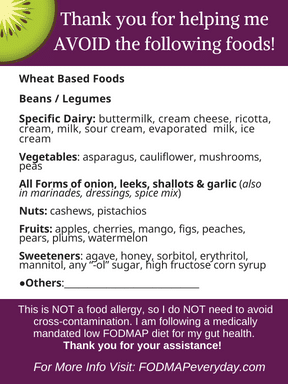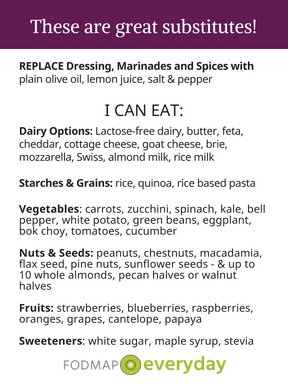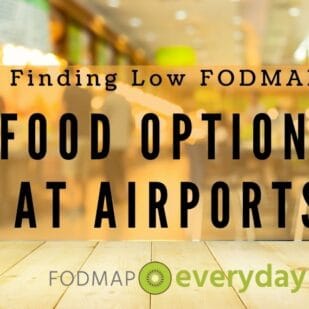Traveling Tips While Following the Low FODMAP Diet
Dédé’s Notes: If you haven’t “met” Diana Reid MPH RD, The Global Dietitian, let us introduce you! She is one of our Success Team members, FODMAP trained by Monash University and King’s College and offers nutritional counseling in English, Spanish and French. She has a very international viewpoint, yet takes a very personal approach to her nutrition coaching.
In fact, you can contact Diana for a free 15-minute counseling session, from wherever you live. We couldn’t think of a better person to help all of us understand the best ways to be prepared for travel, from a RD’s perspective.
Traveling While Following the Low FODMAP Diet Doesn’t Have to Be Complicated
If you know anything at all about the low FODMAP diet for IBS (irritable bowel syndrome), you know that it can be complicated to understand and follow. And certainly traveling while following the low FODMAP diet complicates things.
Don’t Stay Home. Be Bold, But Be Prepared!
Travel can be incredibly rewarding on a deeply personal level. It’s a great way to learn about new places and cultures and explore new regions, and it represents a chance to push outside your comfort zone and learn something about yourself, too. Even better, from a low FODMAP diet perspective, individuals often find that they have LESS IBS symptoms when on holiday, because they are more relaxed and are eating different types of foods.So, put your fears aside, and plan that big vacation or trip to a foreign country! These travel tips will help you plan for and cope with potential food issues along the way.
-
Consider Waiting to Begin the Diet Until After Your Trip.
If you are just getting started on the low FODMAP diet Elimination Phase, you may want to wait until after your trip, as combining multiple factors (including stress and inconsistent eating routines) may not give you the best results. Also, you want to try to enjoy your holiday as much as possible, therefore, starting a brand new, complicated food plan may not be ideal. *Note: If your doctor or dietitian has suggested you start the diet now, include them in your trip planning to be sure you’re getting started on the right foot.
-
Contact Airlines & Railways for Menus.
It’s not likely they will have low FODMAP meals per se, but you may be able to get advance access to the menus and be able to select a few items you can eat. *Warning: A gluten-free meal doesn’t always mean safe. Be sure to double check for high FODMAP ingredients in the meal, such as onion or garlic. Read our Finding Low FODMAP Food Options at Airports article and see our travel tip for snacks below if you can’t find anything that looks safe.
-
Pack Safe Snacks.
You don’t need an entire backpack full, but make sure you have some snacks you know sit well with you for travel in-between cities, on long flights and/or for those times you know you will be away from a proper grocery store or market. Safe crackers, cheese, nut butter, trail mix, muesli bars (like our Soft & Chewy Granola Bars), fruit or cookies/biscuits can make a satisfying meal in a pinch.
Check out our Best Low FODMAP Snacks for On the Run and Finding Low FODMAP Food Options at Airports articles for some great ideas.
-
Pack a Tummy Rescue Kit.
You may not ever need it, but having comfort items on hand to deal with a flare up will help you feel more calm about taking chances and trying new foods. Some things to include: peppermint capsules; peppermint or ginger tea; small hot water bottle; loperamide, Pepto-Bismol or other prescribed medication; low FODMAP fiber supplements; peppermint oil (for external abdominal use) or other comforting items. *Note: Always keep several days of medications with you in your carry-on baggage. Check with the airlines for specific guidance on requirements for carrying liquid or gel medications.
-
Research Local Restaurants & Grocery Markets.
Figure out where you’re staying and do a little online research to scope out low FODMAP options in the area. Often times, you may find websites in certain countries that highlight low FODMAP, gluten free or other specialized restaurants. You can also seek out local Facebook groups that offer information on low FODMAP products and restaurants in the region and get advice from area folks in-the-know.
In addition, here’s a previous article from FODMAP Everyday® that provides general tips on eating out. Finally, if you are really concerned about your chances for finding good low FODMAP restaurants, consider renting an Airbnb or other self-catering style accommodation so you can prepare your own meals.
-
Choose Simple Meals.
Complex items that include sauces, dressings, or lots of different spices may be problematic, especially in a foreign country where you don’t speak the language. Request simple meals that include plain protein (chicken, fish, meat, eggs) and safe sides such as plain potatoes, rice or quinoa, along with plain low FODMAP vegetables, and order sauces and dressings on the side.
For breakfast, stick with eggs and oatmeal, or a safe bread with butter, or nut butter, and low FODMAP fruit. Finally, keep the Monash University Low FODMAP Diet app with you at all times to check items for safety and/or proper portion sizes. For more ideas you can read Great Tips for Eating Low FODMAP On Airplanes.
-
Print Out Low FODMAP Cards in the Local Language.
The diet may not be well understood in the country or region you are traveling to, and as noted above, you may not speak the local language. Avoid having to engage in wild pantomime with restaurant staff or missing out on tasty food offerings by bringing local language cards with you to restaurants and other places you may be eating.
We have handy cards for servers and chefs that you can print out, keep with you, and hand out as needed (see below). You can also use Google Translate and apply them to ours. The Google Translate app also has a great feature that allows you to translate menus from one language to the next “on the fly” by holding your phone over the menu.
-
Manage Your Stress
Travel to new places can be exciting, and also overwhelming at times. Long flights, jet lag, transportation delays, missing luggage or language barriers can amp up the stress levels considerably. Make sure to carve out some time each day to relax and regroup, and get some physical activity daily.
Consider traveling with yoga or meditation apps that you can use anywhere to find a bit of daily zen. This can help reduce the risk of IBS flares and make your holiday more enjoyable overall.
Don’t let tummy troubles rain on your parade. Get out and see the world! You’ll be glad you did.
What are your tried and true travel tips for staying gut healthy on the road? We’d love to hear from you below in the comments!
For More Travel Info:
Be sure to check out our main travel hub article: Traveling with IBS: The Comprehensive Guide.









Thank you for great article here. Also just to say I made your Rhubarb without strawberry crumble this evening it was delicious. Thank you so much. Also I love the app find it so so helpful just marvellous it makes life so much easier.
Hi Sylvia, thank you for taking the time to write and letting us know that we have been helpful!